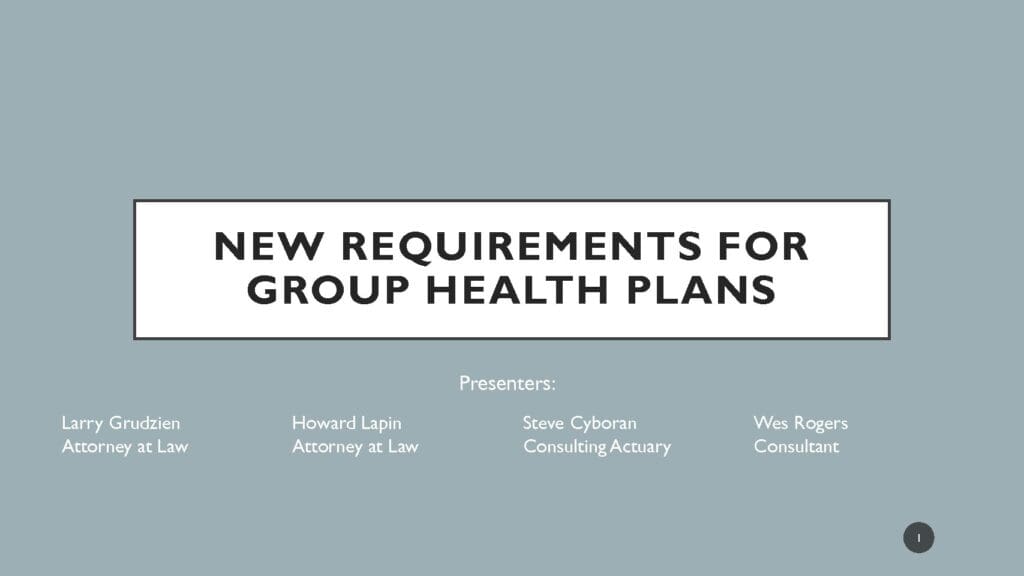Tag: #Prescription Drug Reporting
Transparency Webinar Replay: Big Changes Coming! How to Comply with the Consolidated Appropriations Act (CAA) and Transparency in Coverage Rules!

A replay of and presentation deck for our July 20 Webinar is now available. This webinar addresses several new laws and regulations that significantly impact group health plans and individual insurance coverage. The Consolidated Appropriations Act (CAA), signed into law December 27, 2020, contained the No Surprises Act (NSA) and rules for the additional analysis required for Mental Health Parity (MHP). In addition, the Departments of Labor (DOL), Health and Human Services (HHS), and the Treasury (collectively, the Agencies) issued final “Transparency in Coverage” regulations requiring certain disclosures for group health plans and individual insurance.
Compliance Responsibility for Penalties
The following table summarizes the CAA, NSA, MHP, and Transparency in Coverage rules, including the responsible party, applicability, who will enforce the law or rules, and which party is subject to penalties. As of this date, there are still several uncertainties which we expect to be resolved as more guidance is made available by the DOL, HHS, and Treasury. We are working with the CMS oversight group to determine if, or how, these rules may, or may not, apply to self-funded student health plans.
| Insured Group Health | Self-Funded Group Health | Individual/Insured Student Health | Self-funded Student Health | |
| No Surprises Act | ||||
| Responsible Party | Uncertain | Employer | Uncertain | Uncertain |
| Applicability | Yes | Yes | Yes | Uncertain |
| Enforcement | State, then HHS | HHS, DOL, IRS | State, then HHS | Uncertain |
| Subject to Penalties | Uncertain | Employer | Uncertain | Uncertain |
| Transparency | ||||
| Responsible Party | Uncertain | Employer | Uncertain | Uncertain |
| Applicability | Yes, except Grandfathered Plans | Yes, except Grandfathered Plans | Yes | Uncertain |
| Enforcement | HHS, DOL, IRS | HHS, DOL, IRS | State, then HHS | Uncertain |
| Subject to Penalties | Uncertain | Employer | Uncertain | Uncertain |
| Mental Health Parity | ||||
| Responsible Party | Insurer | Employer | Insurer | MEC Plan Sponsor |
| Applicability | Yes | Yes | Yes | Maybe |
| Enforcement | State, then HHS | HHS, DOL, IRS | State, then HHS | State, perhaps |
| Subject to Penalties | Uncertain | Employer | Uncertain | Uncertain |
| Fee Disclosure | ||||
| Responsible Party | Service Provider1 | Service Provider1 | Insurer | Uncertain |
| Applicability | ERISA Plans | ERISA Plans | Yes | Uncertain |
| Enforcement | DOL | DOL | HHS | Uncertain |
| Subject to Penalties | Service Provider1 | Service Provider1 | Uncertain | Uncertain |
Why is transparency compliance important?
For group health plans, the penalty for non-compliance will be up to $100 per participant per day. For a group of 1,000 affected participants, the penalty could be about $36 million over the course of one year of non-compliance.
Available Support
We developed a Compliance Toolkit to facilitate self compliance, which is now available. Watch a replay of an overview webinar of the Compliance Toolkit. Our team of consultants, including actuaries, clinicians, behavioral health, pharmacy, and legal resources are also available to guide you through the compliance process, or we can take the lead. Please contact us.
Mental Health Transparency Implications
Mental health and substance abuse disorders (MH/SUD) are a big issue as a result of the COVID-19 response, economic shut down, and social isolation resulting from the transition to virtual work and education. As a result, we have seen significant increases in depression, where rates of depression tripled, substance abuse, and opioid use, in particular, where related deaths are were up 80% in 2020 to 90k, expanding on over 40 years of exponential increases in mortality.
With the passage of the CAA transparency rules, health plans are immediately required to conduct a detailed Comparative Analysis of both financial and non-financial treatment limitations if an Agency or plan participant requests the analysis, report, and supporting documentation. The Agencies are ramping up staff to focus on compliance.
In addition to complying with MHP, we also recommend developing a plan to mitigate the behavioral health issues in your organization. Compliance alone will not likely address the impact on your employees. An effective approach will require a more sustainable approach focusing on a purposeful culture, a healthy culture, and cultural alignment of all reward and benefit programs.
The webinar addresses these topics in much greater detail.

